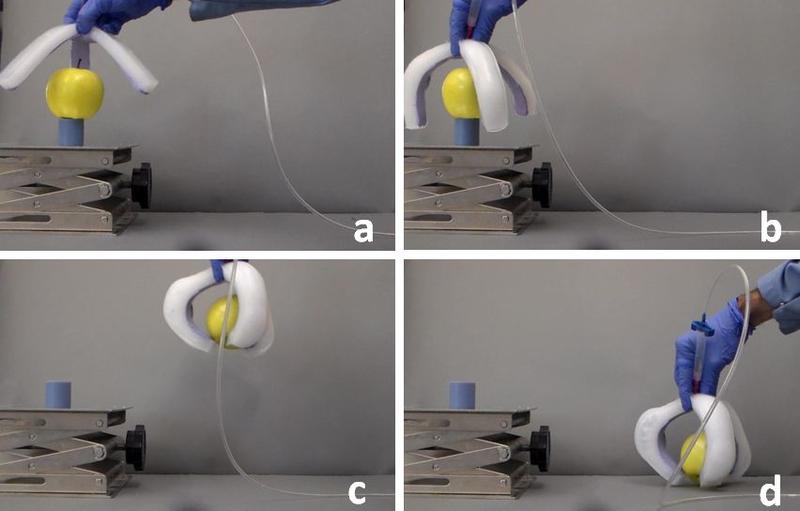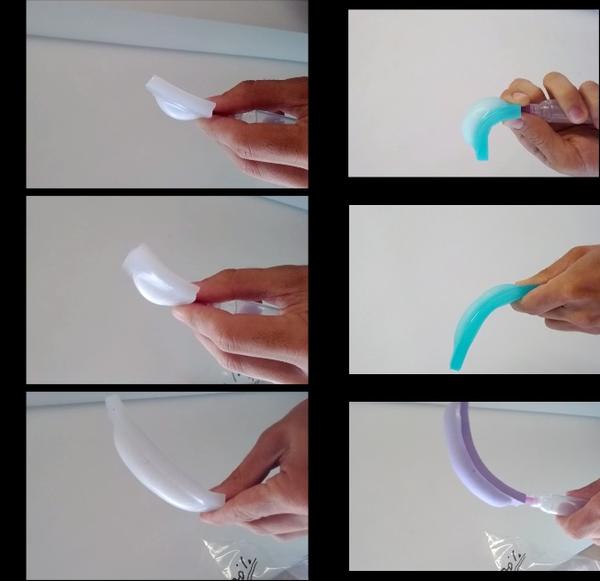Bioinspired Soft Fluid Pump
To demonstrate the utility of foam-based soft actuators, we fabricated a functional fluid pump with a biologically inspired external geometry, the heart.
|
|

|

|
The pump was designed from a digital heart model. We used this model to cast a shell of MoldMax10 (MM10; available from Smooth-On) elastomer foam surrounding the heart geometry (Below Figure a,b). After casting and adhering a nonporous PDMS top, we sliced the device in half (Below Figure c). We then bonded these two halves with woven kevlar/MoldMax60(MM60) composite to form two foam chambers and two liquid chambers (all isolated from each other) within the device. To finalize the device, we painted a MM60/chopped carbon fiber layer on the exterior of the device which directed all foam expansion inwards.

This pump is actuated pneumatically and is composed entirely of soft materials. As shown in the schematic below, the pump is composed of a pure MM10 top [A], pneumatic foam chambers composed of MM10 foam [B], a MM60/woven Kevlar barrier separating the left and right halves [C], pneumatic inputs [D], water-transporting tubing [E], and water chambers [F]. Green represents an inflated foam chamber while red represents an uninflated chamber. W1 and W2 represent valves in water transporting tubing; A1 and A2 represent valves in air transporting tubing. A red “X” indicates a closed valve.

The pump generates water flow using only a single air source and the timed control of four solenoid valves via a microcontroller (Arduino Uno). We used the microcontroller to attain a wide range of pumping frequencies.
The pump attains water flow by alternating between two states: (State 1) valves A1 and W1 are open, valve A2 is venting, and valve W2 is closed; (State 2) valves A2 and W2 are open, valve A1 is venting, and valve W1 is closed. In State 1, air travels from the source through A1 to inflate the left foam chamber. This inflation pressurizes the adjacent left water chamber generating water flow through W1 into the right water chamber. In this state, valve A2 is venting to accommodate compression of the right foam chamber as the right water chamber inflates. The microcontroller then switches all valves to State 2, causing the right foam chamber to inflate, pressurizing the right water chamber and causing water flow through W2 back to the left water chamber.
When pumping water at frequencies of 2, 1, and 0.1 Hz, we observed sustained output flow rates of 190 mL min −1, 370 mL min−1, and 430 mL min−1 at pressures of 20, 14, and 12 kPa, respectively. At the time of publication, the 430 mL min−1 flow rate is 80% faster than the previously highest reported rate from a soft pump.
While pumping, the water flow is pulsatile due to the alternating inflation and venting of each foam chamber; however,throughout each inflation step, the flow is sustained.
Similar to other reported soft pumps, our design is a displacement pump that relies on compliant diaphragms. Unlike other pumps, however, our design does not employ combustion for inflation. Although combustion is a powerful energy source, the complexity in managing the safety and timing is complicated.
Soft Gripper Manufacturing
We manufactured a Y-shaped soft gripper with the table salt foam technique. The soft internal core was fabricated using table salt and Ecoflex 00-30 (available from Smooth-On) with a porosity of 70%. The strain-limiting layer was obtained by placing a Y-shaped paper sheet (cut with scissors). the gripper was sealed with Ecoflex 00-10 and an additional painted thin (about 2mm) OOMOO 30 layer. In this video an example gripper performs a pick and place test.
|
|

Soft Block Actuators examples
With this technique, soft actuators can easily manufactured with different shapes and sizes, just cutting a unique soft foam in different parts. In the picture below there are some examples of different size block actuators while bending.

